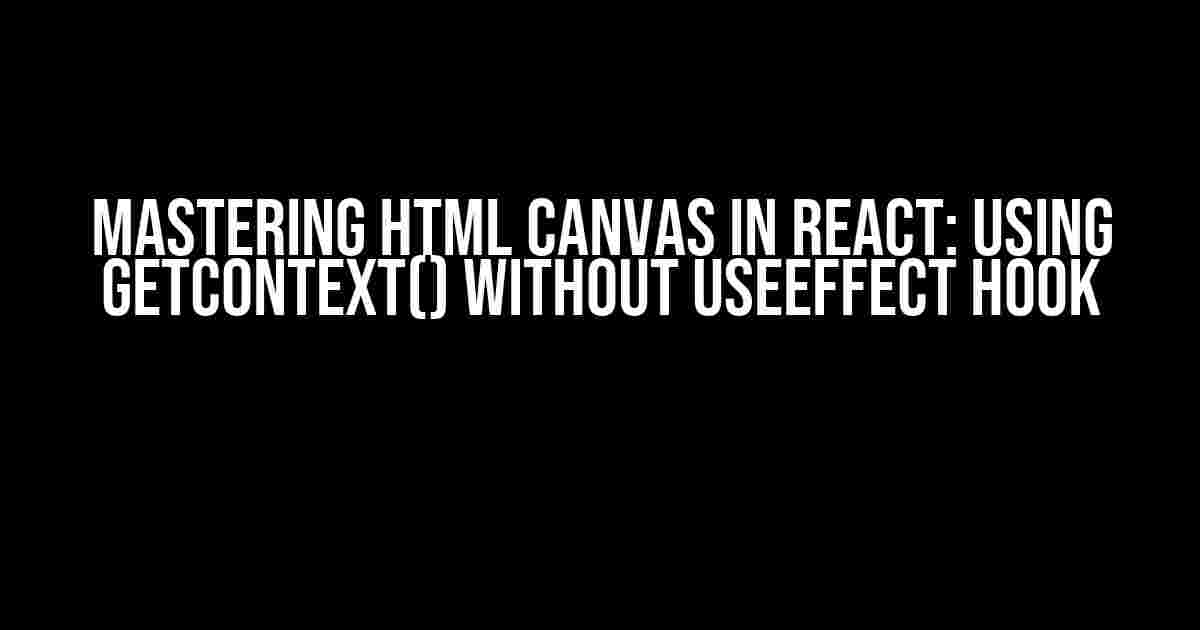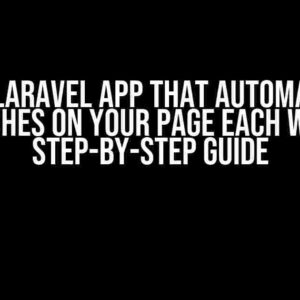Are you tired of being restricted by the limitations of React’s useEffect hook when working with HTML Canvas? Do you want to unlock the full potential of canvas rendering without the overhead of unnecessary re-renders? Look no further! In this comprehensive guide, we’ll dive into the world of HTML Canvas and explore how to use the getContext() method in React without relying on the useEffect hook.
Introduction to HTML Canvas
HTML Canvas is a powerful tool for creating dynamic, interactive graphics on the web. It allows developers to draw and manipulate graphics using JavaScript, making it an essential skill for any modern web developer. However, when it comes to using Canvas in React, things can get a bit tricky. That’s where the getContext() method comes in.
What is the getContext() method?
The getContext() method is used to retrieve the rendering context of an HTML Canvas element. This context is what allows you to draw and manipulate graphics on the canvas. There are several types of contexts, including 2D, WebGL, and WebVR, but for this article, we’ll focus on the 2D context.
<canvas id="myCanvas" width="400" height="200"></canvas>
const canvas = document.getElementById('myCanvas');
const ctx = canvas.getContext('2d');
In the example above, we first retrieve the canvas element using document.getElementById(). Then, we call the getContext() method on the canvas element, passing ‘2d’ as an argument to specify the type of context we want. The resulting ctx object is our 2D rendering context.
The Problem with Using useEffect Hook
When using HTML Canvas in React, it’s common to use the useEffect hook to initialize the canvas and set up the rendering context. This approach works, but it has some limitations. For one, the useEffect hook can cause unnecessary re-renders of your component, which can lead to performance issues. Additionally, the useEffect hook can make it difficult to manage the canvas state, leading to unexpected behavior.
So, how can we use getContext() in React without relying on the useEffect hook? The answer lies in creating a custom hook.
Creating a Custom Hook
A custom hook is a reusable function that encapsulates a specific piece of logic. In our case, we’ll create a hook to handle the initialization and management of our canvas context.
import { useState, useEffect } from 'react';
const useCanvasContext = () => {
const [canvas, setCanvas] = useState(null);
const [ctx, setCtx] = useState(null);
const initCanvas = () => {
const canvasElement = document.getElementById('myCanvas');
if (canvasElement) {
setCanvas(canvasElement);
const context = canvasElement.getContext('2d');
setCtx(context);
}
};
return [ctx, initCanvas];
};
In the above code, we define a custom hook called useCanvasContext(). This hook uses the useState hook to create two state variables: canvas and ctx. The canvas state variable will hold a reference to our canvas element, while the ctx state variable will hold a reference to our 2D rendering context.
The initCanvas function is responsible for initializing our canvas and context. It retrieves the canvas element using document.getElementById(), and then calls the getContext() method to retrieve the 2D rendering context. Finally, it updates our state variables with the retrieved references.
Using the Custom Hook
Now that we have our custom hook, let’s see how we can use it in a React component.
import React from 'react';
import useCanvasContext from './useCanvasContext';
const CanvasComponent = () => {
const [ctx, initCanvas] = useCanvasContext();
if (!ctx) {
initCanvas();
}
if (ctx) {
ctx.clearRect(0, 0, 400, 200);
ctx.fillStyle = 'red';
ctx.fillRect(10, 10, 50, 50);
}
return (
<div>
<canvas id="myCanvas" width="400" height="200"></canvas>
</div>
);
};
In the above code, we import our custom hook and use it in our CanvasComponent. We retrieve the ctx and initCanvas values from the hook, and then use them to initialize and render our canvas.
If the ctx value is null, we call the initCanvas function to initialize our canvas and context. Once the ctx value is set, we can use it to draw on the canvas.
Example Use Cases
Now that we’ve seen how to use our custom hook, let’s explore some example use cases.
Drawing Shapes
One of the most common use cases for HTML Canvas is drawing shapes. Using our custom hook, we can draw shapes on the canvas with ease.
if (ctx) {
ctx.clearRect(0, 0, 400, 200);
ctx.fillStyle = 'blue';
ctx.fillRect(20, 20, 30, 30);
ctx.fillStyle = 'green';
ctx.beginPath();
ctx.arc(100, 100, 50, 0, 2 * Math.PI);
ctx.fill();
ctx.fillStyle = 'yellow';
ctx.fillRect(150, 150, 40, 40);
}
In the above code, we use the ctx object to draw three shapes on the canvas: a blue rectangle, a green circle, and a yellow rectangle.
Handling User Input
Another common use case for HTML Canvas is handling user input. Using our custom hook, we can capture user input events, such as mouse clicks and movements, and use them to interact with our canvas.
const handleMouseDown = (event) => {
const rect = canvas.getBoundingClientRect();
const x = event.clientX - rect.left;
const y = event.clientY - rect.top;
if (ctx) {
ctx.fillStyle = 'black';
ctx.fillRect(x, y, 10, 10);
}
};
return (
<div>
<canvas
id="myCanvas"
width="400"
height="200"
onMouseDown={handleMouseDown}
></canvas>
</div>
);
In the above code, we define a handleMouseDown function that captures the user’s mouse click event and uses it to draw a small black rectangle on the canvas.
Conclusion
In this article, we’ve explored the world of HTML Canvas in React, and learned how to use the getContext() method without relying on the useEffect hook. By creating a custom hook, we can efficiently manage our canvas context and state, without worrying about unnecessary re-renders. Whether you’re building a simple drawing app or a complex graphics-intensive game, the techniques outlined in this article will help you unlock the full potential of HTML Canvas in React.
FAQs
| Q | A |
|---|---|
| What is HTML Canvas? | HTML Canvas is a powerful tool for creating dynamic, interactive graphics on the web. |
| What is the getContext() method? | The getContext() method is used to retrieve the rendering context of an HTML Canvas element. |
| Why should I avoid using useEffect hook with HTML Canvas? | The useEffect hook can cause unnecessary re-renders of your component, leading to performance issues and unexpected behavior. |
| How do I use the custom hook in my React component? | You can use the custom hook by calling it in your React component and retrieving the ctx and initCanvas values. |
We hope this article has been helpful in your journey to mastering HTML Canvas in React. Remember to always keep your code efficient and scalable, and don’t hesitate to reach out if you have any questions or need further assistance!
Frequently Asked Questions
Get ready to unleash your creativity with HTML Canvas in React, minus the useEffect hook!
Can I use HTML Canvas getContext() in a React functional component without useEffect?
Yes, you can! While useEffect is often used to handle side effects, you can use the ref callback function to get the canvas context in a functional component. Simply create a ref using React.createRef(), and then use the ref callback function to get the context.
How do I get the canvas context in a React class component without useEffect?
Easy peasy! In a class component, you can get the canvas context in the componentDidMount lifecycle method. This method is called after the component has mounted, so you can safely get the context and start drawing on the canvas.
What’s the advantage of using a ref callback function to get the canvas context?
Using a ref callback function ensures that you get the canvas context only when the component has finished rendering, which prevents any potential null reference errors. Plus, it’s a more elegant and efficient way to get the context, don’t you think?
Can I use the same approach to get the canvas context in a React Hook?
Unfortunately, no. React Hooks don’t have a direct equivalent to the ref callback function or the componentDidMount lifecycle method. But don’t worry, you can still use the useEffect hook to get the canvas context in a React Hook.
What’s the most important thing to keep in mind when working with HTML Canvas in React?
The most crucial thing is to ensure that you get the canvas context only when the component has finished rendering, and the canvas element is available in the DOM. This will save you from a world of trouble and ensure that your canvas magic works as expected!


